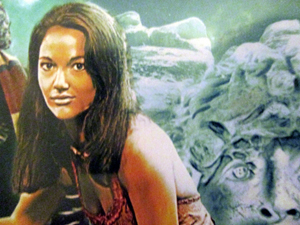The Face of Evil
“Answers are easy. It’s asking the right questions that is hard.” – The Doctor
This story was already a favorite of mine in childhood and watching it this time I really came to like it even more. Its strongest asset is a set of great sci-fi concepts that are revealed little by little as the show progresses, just slow enough to be a surprise but not so dragged out that it’s all left for the end. On top of that, it introduces one of my top favorite companions Leela. She gets off to a very strong start and we see the Doctor making some very explicit boundaries of what he expects in a companion. Some of the design is a bit hokey by today’s standards but overall there are some really neat elements as well.
The story concept is so cool—after the Doctor visited a spacecraft ages before, his attempt to create a mind link with the powerful computer actually left it with a schizophrenic personality. In its madness, the computer separates the original crew of the ship and sets each group on a path to becoming established on the planet down the generations—the survey team becomes the ‘Sevateem’ tribe in the wilderness and the ship technicians become the Tesh on board. Each group devolves, forgetting their origins, and the computer enhances brute strength and brave stealth in the one and technical know-how and telepathic powers in the other. Placed in constant war with one another, the two groups also come to worship the voice of the computer as a god—the objects of their ancestors’ space travels now religious relics. The face of the computer (now called Xoanan) is that of the Doctor whom it cannot separate itself from, and his face has become known as one of evil by the Sevateem since they believe he is the one holding Xoanan captive. When the Doctor arrives again to find all of this, it creates an existential crisis in the computer that almost causes the destruction of the entire planet.
As I said, all of this back story comes out not at once in order but in pieces with small clues and hints along the way: hearing a bit of the Doctor’s voice from the computer speaker, seeing a gong made of the survey team ship panel, and especially the Doctor realizing that the primitive Sevateem’s gesture to ward off evil is the sequence of checking the seals on a Starfall Seven spacesuit. (“And what makes that particularly interesting is that you don’t know what a Starfall Seven spacesuit is, do you?”) It also leads to some great surprise reveals like finding the Doctor’s face carved in the side of a mountain or the invisible creatures being psychic manifestations of the Doctor’s face. (There is some cool effects work to show this.)
While all this is going on, there is also a lot of interesting character development for Leela. She has dared to openly question the truth of their religion and is banned for it. Her open mind impresses the Doctor. She is still savage—unreservedly killing enemies with a Janis thorn for example—until the Doctor very strongly remonstrates her, basically giving her one chance to stop. (“Who licensed you to slaughter people? No more Janis thorns, you understand? Ever.”). She very quickly falls at his heel to help him like an old friend while he appreciates her courage and quick learning. Indeed, he becomes quite fierce when she is nearly killed by Calib. It’s also significant that with him she can drop pretense and be relaxed and teasing. The Doctor sets her up to get rid of superstition, establishing a kind of professor/student relationship. It was also bit of surprise in watching to realize that the Doctor didn’t so much choose her as a companion but rather she showed him she was coming with him like it or not.
In general, there is also just some enjoyable repartee between the Doctor and other characters throughout (lots of fun with jelly babies) and some dramatic wrangling for power among the tribes. There is also a quite heavy underlying commentary on superstition and science and religion—especially with the way that Neeva is able to manipulate every situation to affirm his belief even when seemingly contradictory.
Best (or worst) unsettling moment:
The intense yelling of the split personality of Xoanan while the Doctor lies in agony on the floor is quite startling, especially when a child’s voice starts screaming “Who am I? Who am I?”
Regrets:
The dramatic ambush at the wall is rather underwhelming, a constraint of budget perhaps. I wish the suits of the Tesh and other design elements like the mass of Horda did not come across so dated now since people might be dismissive of a good story because of them. The skimpiness of some of the Sevateem’s loincloths is a bit of a shock as well!

